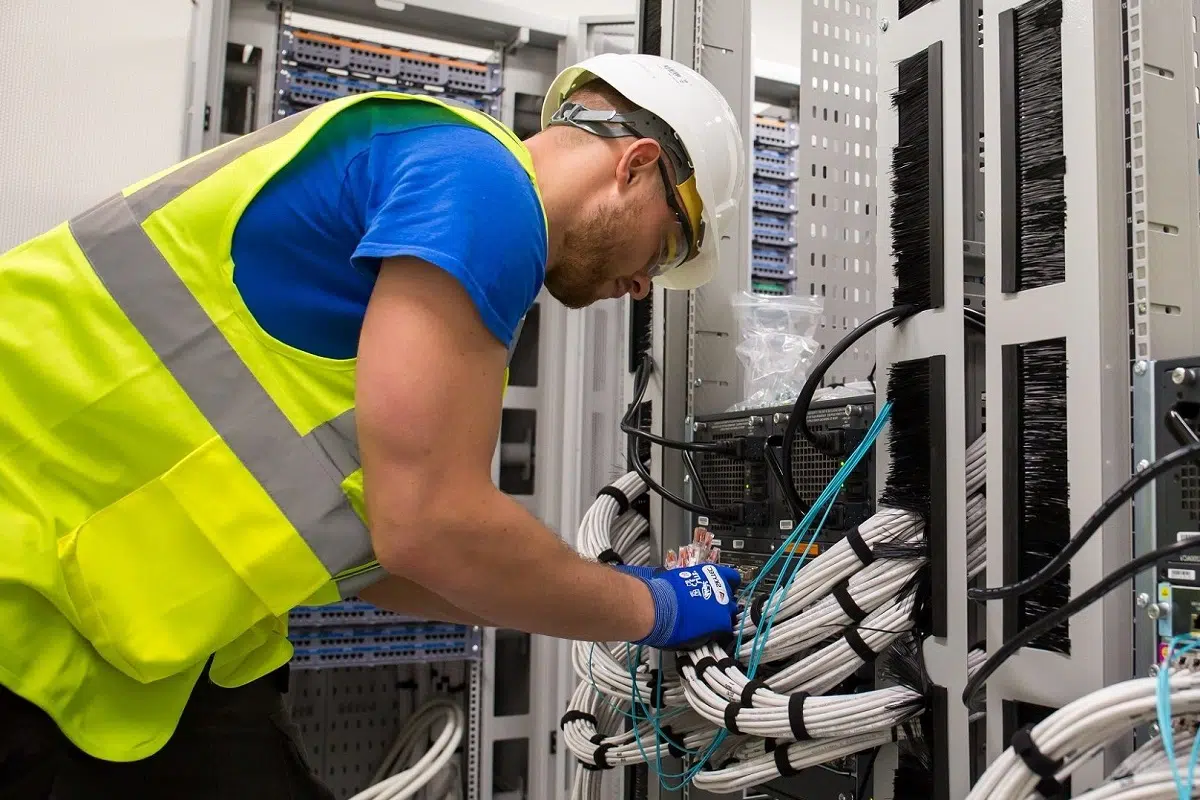Step-by-Step Guide to Planning a Data Cabling Installation for Scalability

You’ve probably seen it happen before. An office moves into a shiny new space, sets up computers, phones, and Wi-Fi routers, and everything works perfectly for a while. Fast forward a few years, and suddenly the network feels like it’s running through molasses. Employees complain about slow connections. New hardware doesn’t fit into the existing setup. Expansion becomes a nightmare. What happened?
The truth is, most of those problems start at the foundation: the cabling. If your network cabling installation wasn’t designed for growth, you’ll feel the pain later. And trust me, retrofitting is always more expensive, disruptive, and frustrating than doing it right the first time.
That’s where this step-by-step guide to planning a data cabling installation for scalability comes in. Whether you’re building out a new office or upgrading your current setup, these steps will help you think ahead, avoid costly mistakes, and create an infrastructure that grows with you.
Step 1: Start with the End in Mind
Here’s the first question: What does your office look like today, and what might it look like in five years?
It’s tempting to design your network for the present. Maybe you have 20 employees and a handful of conference rooms. But what if your team doubles? What if you add new departments, smart devices, or cloud-based systems that demand higher bandwidth?
Scalability starts with vision. Talk to leadership about long-term growth plans. Ask about hiring goals, future office locations, and new technology they might adopt. Even if plans change, this exercise will help you build flexibility into the design.
Step 2: Assess Current and Future Bandwidth Needs
Data cabling isn’t just about connecting devices; it’s about delivering speed and reliability. And bandwidth needs can skyrocket fast.
Think about this: a single 4K video conference eats up way more bandwidth than a standard call. Add cloud backups, IoT sensors, and dozens of employees streaming and working simultaneously, and suddenly your “good enough” wiring starts to choke.
Here’s the rule of thumb: plan for at least double what you think you’ll need today. Cabling isn’t something you want to rip out every few years. If you’re on Cat5e now, think about Cat6 or Cat6a. Fiber optics might be worth considering if you expect heavy data use across large distances.
Step 3: Map Out the Physical Layout
Close your eyes and walk through your office space. Where will workstations go? Where will printers, servers, wireless access points, and conference systems sit? Every cable has to run somewhere, and without a thoughtful layout, you risk a messy spaghetti monster above the ceiling tiles.
Create a floor plan. Mark every outlet, device, and access point. Plan for cable routes that minimize interference, avoid excessive bends, and comply with building codes.
Pro tip: Leave extra room in your conduits and pathways. That “empty space” will save you when it’s time to expand.
Step 4: Choose the Right Cable Types
This is where decisions really start to impact scalability. The wrong choice here could lock you into limitations.
- Cat5e: Affordable, but already dated. It’s fine for basic office setups, but won’t hold up to future demands.
- Cat6: The current workhorse. Supports Gigabit Ethernet and works well for most small-to-medium businesses.
- Cat6a: Better shielding, supports 10 Gigabit Ethernet, and is more future-proof.
- Fiber Optic: Ideal for high-bandwidth, long-distance runs. More expensive, but increasingly essential for growing offices.
Ask yourself: Is saving a few dollars per foot worth the headache of upgrading in two years? Usually, it’s not.
Step 5: Centralize with a Strong Backbone
Think of your cabling system like a tree. The cables to desks and devices are the branches, but they all need a sturdy trunk the backbone. That backbone usually runs from a central server room or data closet.
Plan for a secure, climate-controlled space with enough power and ventilation to handle growth. Don’t cram your networking gear into a broom closet. Give it room to breathe, expand, and function reliably.
Step 6: Don’t Overlook Low-Voltage Needs
Scalability isn’t just about internet speed. Modern offices rely heavily on low-voltage wiring for security systems, intercoms, alarms, cameras, and IoT devices.
If you skip planning for low-voltage wiring now, you’ll regret it when you realize you can’t install new surveillance cameras or access control systems without tearing open walls.
Bundle this planning into your cabling project from the start.
Step 7: Build in Redundancy
Here’s a scenario: someone accidentally severs a cable during renovations. Suddenly, half your office goes offline. Productivity tanks.
That’s why redundancy matters. Build extra capacity and alternative paths. Even a small business benefits from backup connections that keep the lights on when something goes wrong.
Step 8: Label Everything
It sounds boring, but labeling is your secret weapon for scalability. Imagine trying to trace a single cable in a tangled mess five years from now. You’ll waste hours—unless you label properly today.
Color-code cables. Use tags with clear identifiers. Document the layout in a master plan. Your future IT team (and your sanity) will thank you.
Step 9: Test, Test, Test
A scalable system isn’t just designed it’s proven. Once installation is complete, run thorough testing. Verify that every cable meets performance standards. Test for interference, signal strength, and bandwidth capacity.
Catching issues now is far cheaper than discovering them later when your office is relying on the system.
Step 10: Document Everything
Here’s the part almost everyone skips: documentation. Scalability means knowing exactly what you have so you can expand without guesswork.
Create a record that includes:
- Floor plans
- Cable types and lengths
- Port numbers
- Pathways and conduits
- Device connections
Store this digitally so it’s accessible for future contractors or IT staff.
Step 11: Factor in Compliance and Safety
Cabling isn’t just about performance. Fire codes, safety standards, and industry regulations matter too. Non-compliance can lead to costly fines or worse, force you to rip out and redo your installation.
Work with certified professionals who understand NEC (National Electrical Code) and local building requirements.
Step 12: Think About Growth Beyond the Walls
Scalability doesn’t stop at your office door. Remote work, cloud services, and multi-location connectivity are part of modern business. Consider how your cabling integrates with these external needs.
Ask yourself: If we open another office next year, how easily can we connect systems?
Step 13: Partner with the Right Contractor
Even the best plan fails without skilled execution. Choosing the right contractor is arguably the most critical step. Look for professionals with experience in scalable cabling projects, solid references, and industry certifications.
A good contractor won’t just run wires they’ll consult, anticipate growth, and leave you with a system that adapts to change.
Real-World Example: The Office That Didn’t Plan Ahead
One company I worked with had installed Cat5e cabling years ago when they only had 15 employees. Fast forward: they had 60 employees, video conferencing in every room, and IoT devices across the office. The network crawled.
Upgrading meant ripping out walls, halting operations, and spending triple what it would have cost if they’d planned ahead. All because they didn’t think long-term.
Don’t let that be your story.
Wrapping It All Up
Scalability doesn’t happen by accident. It’s the result of thoughtful planning, forward-looking choices, and solid execution. From assessing bandwidth to choosing cable types, mapping layouts, and partnering with the right contractor, every step builds the foundation for growth.
Yes, it takes effort now. But compare that to the chaos of ripping out cabling in three years, and the choice becomes obvious.
So the next time you’re preparing a new office or refreshing your current setup, remember: your cabling isn’t just wires in the wall. It’s the backbone of your business’s future.
Final Word
This step-by-step guide to planning a data cabling installation for scalability isn’t about making things complicated it’s about making things easier down the line. Your employees, your IT team, and even your bottom line will thank you for doing it right today.
And if you’re ready to take the leap but don’t want to go it alone, Network Drops has been helping businesses design scalable, future-ready cabling systems for years. From planning to installation and ongoing support, their team ensures your infrastructure won’t just meet today’s needs, but tomorrow’s as well.




